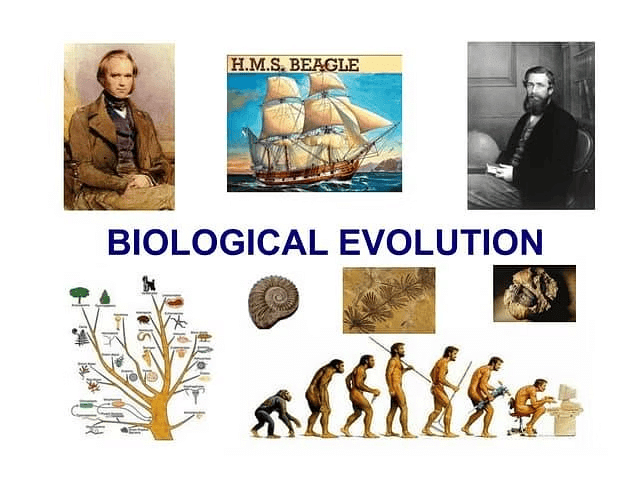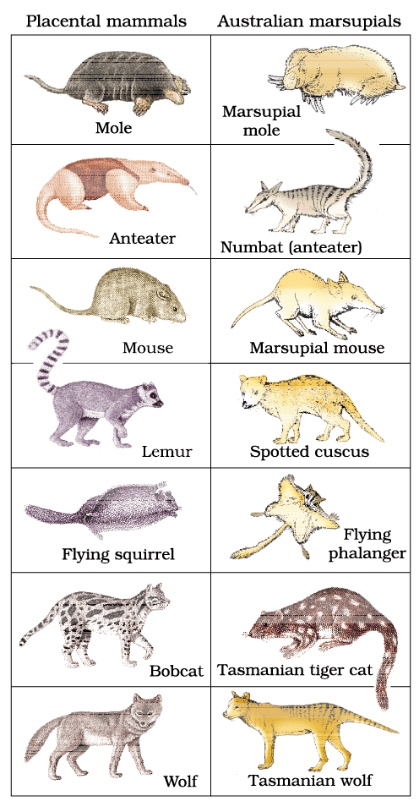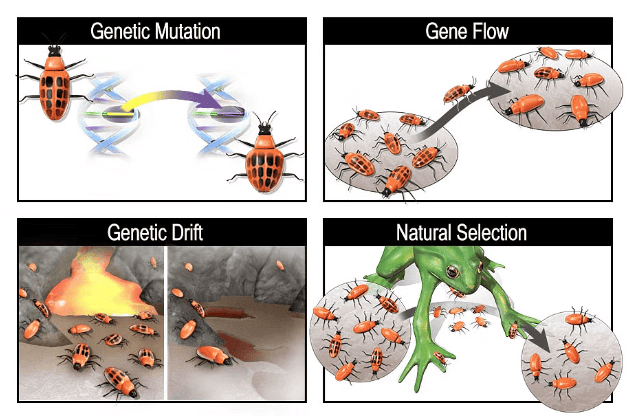Biological Evolution & Mechanism of Evolution | Biology Class 12 - NEET PDF Download
Biological Evolution
Evolution by natural selection likely began when different cellular forms of life with varying metabolic capabilities emerged on Earth. At the core of Darwin's theory of evolution is the concept of natural selection.

Evolution by Natural Selection
- The rate at which new forms of life appear is closely linked to their life cycle or lifespan. For instance, microbes that reproduce rapidly can multiply into millions within a matter of hours.
- Consider a colony of bacteria (let's call it colony A) growing on a specific medium. Within this colony, there is inherent variation in the ability to utilize a particular feed component. If the composition of the medium changes, only that part of the population (let's say colony B) that can survive under the new conditions will thrive. Over time, this variant population outgrows the others and eventually appears as a new species, a process that can occur within days.
- In contrast, for similar changes to occur in organisms like fish or birds, it would take millions of years due to their longer lifespans. In this scenario, we can say that the fitness of colony B is greater than that of colony A under the new conditions. Nature selects for fitness, which is based on inherited characteristics. Therefore, there must be a genetic basis for selection and evolution.
Adaptive Ability and Fitness
Adaptive ability, which is inherited and has a genetic basis, determines an organism's fitness. Fitness is the outcome of the ability to adapt and be selected by nature.
The key concepts of Darwin's Theory of Evolution are branching descent and natural selection.

Lamarck's Theory
Before Darwin, the French naturalist Lamarck proposed that the evolution of life forms occurred through the use and disuse of organs. He argued that giraffes, in their efforts to reach leaves on tall trees, gradually elongated their necks and passed this acquired trait to future generations. Over time, this led to the evolution of giraffes with long necks. However, this idea is no longer accepted.
Evolution: Process or Result?
When we observe the world around us, both living and non-living, we see the outcomes of evolution. In this context, evolution is described as a process. However, when we examine the history of life on Earth, we view evolution as a consequence of a process known as natural selection. The distinction between considering evolution and natural selection as processes or as results of unknown processes remains unclear.
Darwin's Insight
Darwin's insight was the recognition that heritable variations, which enhance resource utilization for some individuals, enable them to reproduce and leave more offspring. Over many generations, these survivors contribute to a change in population characteristics, leading to the emergence of new forms of life.
Natural Selection: Key Observations
- Natural resources are limited.
- Population sizes remain stable with seasonal fluctuations.
- Members of a population exhibit variations in characteristics, and no two individuals are exactly alike, despite superficial similarities.
- Most variations are inherited.
Theoretical population growth is exponential if every individual reproduces to the maximum. However, in reality, population sizes are limited, indicating competition for resources. Only some individuals survive and thrive, while others do not.
Darwin's novel and brilliant insight was the idea that heritable variations that improve resource utilization for certain individuals (those better adapted to their habitat) will enable these individuals to reproduce more successfully and leave more offspring. Over time, across many generations, these survivors will contribute to changes in population characteristics, leading to the appearance of new forms of life.
Mechanism of Evolution
Variation within a species is crucial for the process of evolution. But where does this variation come from, and how does it lead to the formation of new species, a process known as speciation? Even though Mendel had talked of inheritable 'factors' influencing phenotype, Darwin either ignored these observations or kept silence.

In the early 20th century, a scientist named Hugo de Vries, based on his research on evening primrose plants, introduced the concept of mutations. He proposed that these mutations, which are large and sudden changes in a population, are the primary drivers of evolution, rather than the small, gradual variations that Charles Darwin had emphasized.
Key Differences:
- Mutations: According to de Vries, mutations are random and directionless. They can cause significant changes in a population in a short period of time. This idea led him to believe in a process called saltation, where new species could arise suddenly from these large mutations.
- Darwinian Variations: Darwin, on the other hand, focused on small, heritable variations that are directional and occur gradually over time.
While Darwin viewed evolution as a slow and gradual process, de Vries argued that mutations could lead to rapid changes and the emergence of new species. Over time, studies in population genetics have provided more clarity on these concepts and how they fit into the broader understanding of evolution.
|
59 videos|290 docs|168 tests
|
FAQs on Biological Evolution & Mechanism of Evolution - Biology Class 12 - NEET
| 1. What is biological evolution? |  |
| 2. What are the main mechanisms of evolution? |  |
| 3. How does natural selection work? |  |
| 4. What role do mutations play in evolution? |  |
| 5. Can evolution occur rapidly? |  |






















